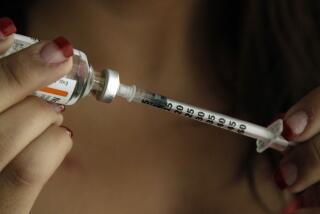Insulin Pump Frees Diabetic Kids of the Need for Shots
- Share via
When Lindsay Tabacchini hangs upside-down off the sofa, her tummy pokes out and you can see the little black case that’s fastened around her waist.
Slightly larger than a beeper, the device is an insulin pump, sending the hormone into her system at the touch of a button. The pump has helped transform the 3 1/2-year-old from a lethargic, cranky child into an energetic, happy little girl. And it’s normalized life for her parents, who are no longer subjected to the strict eating schedules they had when she was taking shots of insulin.
“It’s been amazing,” says Carolyn Tabacchini of the eight months that Lindsay has had the pump. Carolyn and her husband, Frank, an orthodontist, also have a 6-year-old daughter, Victoria, and Lindsay’s identical twin, Olivia. They live in Wilton, Conn.
Lindsay is one of a growing number of younger children using the pumps, not only for their ease and effectiveness, but because pediatric endocrinologists now believe they can prevent the long-term problems associated with diabetes, such as eye and kidney damage, according to Stephen G. Rosen, a Stamford, Conn., endocrinologist.
“If you want to prevent those problems, you have to impact on children before puberty,” he says.
Lindsay was diagnosed with diabetes at age 16 months, after months of extreme thirst and frequent urination. Her parents knew something was wrong. “You know how a diaper looks when you put it into the pool? That’s what hers looked like after two hours,” Carolyn says.
When Lindsay’s urine was tested, her blood sugar reading was so high the lab staff asked Carolyn whether she had stored the sample in a honey jar. In juvenile (or type 1) diabetes, the pancreas is unable to produce insulin, which is needed to process carbohydrates. The family was referred to the Yale Pediatric Diabetes Program at Yale-New Haven Children’s Hospital. After the diagnosis, Frank and Carolyn injected Lindsay with insulin twice a day and pricked her skin eight times a day to test her blood sugar levels. The toddler was on a strict eating regimen, including a bedtime snack of proteins and carbohydrates, such as peanut butter on bread or half of a sports bar.
“Food was always an issue,” Carolyn says. “If she didn’t want to eat, that was the biggest burden.”
Once Lindsay’s blood sugar level was corrected and stabilized, she thrived. She had always lagged behind her twin in height and development, but soon began catching up.
“Her body was starving,” Carolyn says. “We didn’t realize it until she began to feel better.”
Despite the improvement, the Tabacchinis struggled with keeping Lindsay stable. “I was always on the phone, ‘What do I do? What do I do?’ ” Carolyn says.
So last spring, just before Lindsay’s third birthday, the staff at Yale and the Tabacchinis decided to begin using the insulin pump.
The Tabacchinis were concerned about how Lindsay would adjust to the pump. But she began feeling so much better after using it, she became protective of it. “When I would take it off for her bath, she would say, ‘Where’s my pump?’ ” says Carolyn.
The pump works this way: After using a bit of numbing lotion, Carolyn inserts a 2-inch catheter under the skin of Lindsay’s buttock via a needle. She slips the needle out and the tube stays under the skin. The tube is held in place with a small adhesive patch. Another small tube is attached from the catheter to the pump at the child’s waist. The pump, held in a pouch that attaches to Lindsay’s waist with a belt, has a reservoir that holds enough insulin for a week. The pump releases a small amount of insulin into her body continuously, called the basal level. Every time Lindsay eats, she must get an extra dose, called a bolus.
JoAnn Ahern, a diabetes clinical nurse specialist and the program coordinator at Yale, says the buttocks are the best place to attach the catheter, although the abdomen can also be used as long as the child’s pants don’t interfere. Lindsay’s parents switch the catheter from one buttock to the other every other day.
To determine how much extra insulin Lindsay needs when she eats, her parents must count carbohydrates by examining the label of everything she eats. “It makes you an expert in food,” says Frank.
For example, Lindsay has a cup of orange juice. The label on the juice container says that 8 ounces contains 26 grams of carbohydrate. The cup has about 4 ounces in it, so that’s 13 grams of carbohydrate. The doctors have determined that Lindsay needs one-tenth of a unit of insulin for every 3 grams of carbohydrate she consumes. So that’s 13 divided by 3, multiplied by 1/10 equals 0.4. Carolyn inputs 0.4 into the pump and it delivers the insulin to Lindsay.
“Hopefully, by the time she’s 10, she’ll learn to count carbohydrates herself,” says her mom.
Lindsay’s blood sugar level is still tested eight times a day with a finger prick.
Rosen said the next big thing will be an all-inclusive unit that will test, calculate and deliver automatically.
Olivia has barely noticed her twin’s pump. “We were prepared to get a fake pump for her, so she could be the same, but we never needed to,” says Carolyn.
Besides removing the pump for bathing and swimming, the only other consideration is static, which can wipe out the programming in the device. So it must be removed if Lindsay slides down a plastic slide or plays in a ball pit. And once, Lindsay cut the tubing with a pair of play scissors. Other than that, it’s no problem. Even when she hangs upside-down off the sofa.





